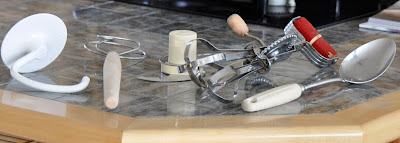
Monday, March 12, 2012
Equipment--Mixing
How you mix bread depends largely on what kind of dough you're mixing.
On the left of the photo is a dough hook for an electric mixer. This works, but it's hard to tell much without touching the dough. The big advantage of a mixer, if you have to use a machine, is that it doesn't overheat or overmix the dough as easily as a food processor does.
Second from left is a bread mixing tool. It does a very good job of getting thinner mixtures, like starters and sponges, smooth. I like it a lot, but it's not strictly necessary. A good spoon will do the same thing with a little more work.
Third is a Cuisinart blade. I use a Cuisinart only for pizza dough, or for thin mixtures such as soakers and starters--I'll go into that later.
For other breads, I find the dough gets too tough. This is especially a problem with fat free doughs, such as French bread. Also, a Cuisinart doesn't hold much, and it's easy for the dough to get under the blade and onto the shaft. I completely destroyed one Cuisinart, trying to make rye bread in it.
Fourth is an old eggbeater. These work very well for thin mixtures such as starters. A hand held electric mixer would probably do the same thing.
Last is an old fashioned spoon. Ones like this aren't made anymore, as far as I know, and I like them much better for bread than anything that is made now. Fortunately, they're still quite inexpensive to buy on auction sites or sites that sell vintage kitchenware. You can even still find them in thrift stores. I love them because the handle is comfortable, the shaft won't bend or break, and the spoon itself is sturdy enough and has enough of an edge to cut dough.
Subscribe to:
Post Comments (Atom)

No comments:
Post a Comment